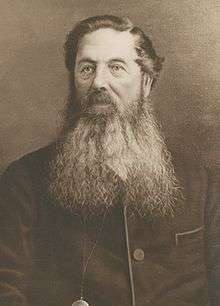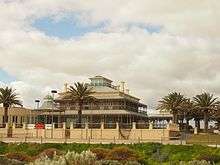Frederick Estcourt Bucknall
| Frederick Estcourt Bucknall | |
|---|---|
 right | |
| Born |
1838 London |
| Died |
4 June 1896 (aged 57) North Adelaide, South Australia |
| Occupation | South Australian politician, businessman |

Tennyson, South
Frederick Estcourt Bucknall (c. 1838 – 4 June 1896) generally known as F. Estcourt Bucknall or F. E. Bucknall was a publican, brewer and politician in the early days of the colony of South Australia.
History

He was a member of the Estcourts of Estcourt, an influential old family, in the counties of Gloucester and Wilts, but born in London, where his father, William Bucknall of Crutched Friars, was Commodore of the Royal Thames Yacht Club.[1]
Shortly after arriving in South Australia around 1860[1] via Melbourne, the original Torrens dam was nearly completed, and he built a fleet of fine pleasure craft which he placed on the lake for hire, but the dam failed and was washed away, putting paid to his enterprise. He built a boatshed on the Port River to the south-east of where the Jervois Street bridge was later built, and created a great deal of interest in sculling on the Port River. He gained approval as a Licensed Victualler and built the South Australian Club Hotel in Vincent Street, Port Adelaide near the site of his boatshed.[1] He married the widow of Mr. H. Haussen, of Haussen & Catchlove, proprietors of the Hindmarsh Brewery. Subsequently he became a partner in the business with F. S. Botting, which continued as Haussen & Co.[2]
In 1878 Bucknall and Arthur Harvey (later to be his parliamentary colleague) formed the Grange Land and Investment Company, to develop the suburb of The Grange.[3]
The business prospered and he became a wealthy man, in 1883 building a magnificent mansion "Estcourt House" on the seafront between The Grange and Glanville. He and Mrs. Bucknall went on a visit to England. While they were away the land boom turned to bust, and with the failure of the Commercial Bank of South Australia in 1886, he lost much of his fortune[2] and was forced to relinquish his mansion to the AMP Society and find employment in the office of E. Benda and Co. of Grenfell Street.[2]
Bucknall died at his residence in Childers Street, North Adelaide.
Politics
Bucknall entered Parliament as a member for West Torrens on 8 April 1881[4] as a colleague of W. H. Bean, and was elected for another three years in 1884 with Arthur Harvey ( – 25 January 1902) with a break 1885–1886 while he visited England for his health.[1]
Bucknall was a supporter of projects to build the Outer Harbor and the North–South Railway, but for some he was remembered as having instituted mandatory horse troughs outside licensed premises.[5]
Civic life
Bucknall was Mayor of Hindmarsh in 1881, 1882 and 1883, a position he filled with distinction.
Other interests
In his youth he was a boxer, athlete and president of the Hindmarsh Cricket Club, of which he was patron for over ten years prior to his death.[2]
He was an enthusiastic rower, swimmer and yachtsman. He went in for boatbuilding, and owned the yachts Brilliant, Rosa and Enchantress, which he bought from Sir Thomas Elder (and eventually sold to Mr. Cunningham).
He was for some time secretary of the Licensed Victuallers' Association, and president for six years. He was made a life member in recognition of this service.
He was an excellent musician, and was at one time organist of the South Australian Grand Lodge of Freemasons, of which he was a member.[1]
Family
On 1 October 1874 he married Rosa Haussen (née Catchlove) (7 December 1840 – 23 November 1899), the widow of Henry Herman Haussen (1830–1870);[6] her children by her first husband included:
- Emily Mary Haussen (born 1859) married Harry Walker ( – 25 November 1886)[7] on 20 April 1881[8]
- Rosa Henrietta Haussen (2 November 1860 – 29 November 1915) married Arthur Wellington Ware (1867 – 29 January 1927)[9] on 11 March 1884[10]
- Ellen Florence Haussen (12 April 1862 – 9 February 1878)[11]
- Ada Haussen (1864 – 29 December 1952) married William John Allsop Begg (c. 1866 – 29 September 1947)
- Amelia Haussen married architect Arthur Dan Bendle Garlick (c. 1863 – 27 June 1901)[12] on 8 April 1890
- Anna Hermanna Haussen (6 January 1871 – 14 March 1943) married solicitor George Andrew Greer ( – 1 May 1905)[13] on 18 June 1890
- Henry Spencer "Spence" Haussen (3 September 1865 – ) moved to Queensland.
Children by her marriage to Bucknall were three daughters and a son,
- Frederick Bucknall, jun. (23 May 1878 – c. November 1903) lost in the sinking of the Loch Bredan.[14]
Rosa married one more time, to John Huxtable Wesley Perryman (c. 1837 – 1923) and moved to Mount Magnet, Western Australia.
It should be noted that, by the terms of their father's will, the children of H. H. Haussen were very well provided for[11] and were prominent in business and society, while those of F. E. Bucknall shared their parents' straitened circumstances, and have lapsed into obscurity.
Memorials
Estcourt House was purchased by the trustees of the legacy of Jessie Brown (ca.1826 – 13 November 1892), wealthy widow of pastoralist James Brown of Avenue Ranges station (near Naracoorte) and Waverley House, Glen Osmond, for the care of crippled children (most suffering or recovering from tuberculosis, poliomyelitis or rheumatic fever) and the aged blind.[15] The building was the prominent location for the movie Struck by Lightning.[16]
References
- 1 2 3 4 5 "The Late Mr. F. E. Bucknall". South Australian Register. Adelaide: National Library of Australia. 5 June 1896. p. 5. Retrieved 10 February 2013.
- 1 2 3 4 "The Late Mr. F. E. Bucknall". The Advertiser. Adelaide: National Library of Australia. 5 June 1896. p. 6. Retrieved 10 February 2013.
- ↑ http://www.charlessturt.sa.gov.au/webdata/resources/files/Local_history_factsheet_-_Grange.pdf Charles Sturt Council: A brief history of the suburb Grange
- ↑ "Frederick Estcourt Bucknall". Former Member of Parliament Details. Parliament of South Australia.
- ↑ "Early Breweries.". The Mail. Adelaide: National Library of Australia. 27 November 1926. p. 17. Retrieved 12 February 2013.
- ↑ "Family Notices.". South Australian Register. Adelaide: National Library of Australia. 29 December 1870. p. 4. Retrieved 11 February 2013.
- ↑ "Family Notices.". South Australian Register. Adelaide: National Library of Australia. 2 December 1886. p. 4. Retrieved 11 February 2013.
- ↑ "Family Notices.". South Australian Register. Adelaide: National Library of Australia. 3 May 1881. p. 4. Retrieved 11 February 2013.
- ↑ "Family Notices.". The Register. Adelaide: National Library of Australia. 31 January 1927. p. 6. Retrieved 11 February 2013.
- ↑ "Family Notices.". The Advertiser. Adelaide: National Library of Australia. 11 March 1909. p. 6. Retrieved 11 February 2013.
- 1 2 "Law and Criminal Courts". South Australian Register. Adelaide: National Library of Australia. 23 December 1878. p. 1 Supplement: Supplement to the South Australian Register. Retrieved 11 February 2013.
- ↑ "Family Notices.". The Queenslander. National Library of Australia. 6 July 1901. p. 8. Retrieved 11 February 2013.
- ↑ "Poison in Mistake". The Register. Adelaide: National Library of Australia. 3 May 1905. p. 4. Retrieved 11 February 2013.
- ↑ "The Barque Loch Bredan". The Register. Adelaide: National Library of Australia. 25 January 1904. p. 4. Retrieved 11 February 2013.
- ↑ "Friday, November 18, 1892.". The Narracoorte Herald. SA: National Library of Australia. 18 November 1892. p. 2. Retrieved 6 July 2014.
- ↑ "Struck by Lightning (1990) - Filming Locations - IMDb". imdb.com. Retrieved 19 May 2016.
Further reading
Hardy, Mabel (1965), The career of Frederick Estcourt Bucknall from his arrival in South Australia, in 1860, to his death in 1896 (with special reference to the North–South Railway, and his proposal for a southern terminal and canal, at Grange, South Australia), Mabel Hardy, retrieved 11 February 2013 This spiral-bound work is available only at the Northern Territory Library, and may not be borrowed.